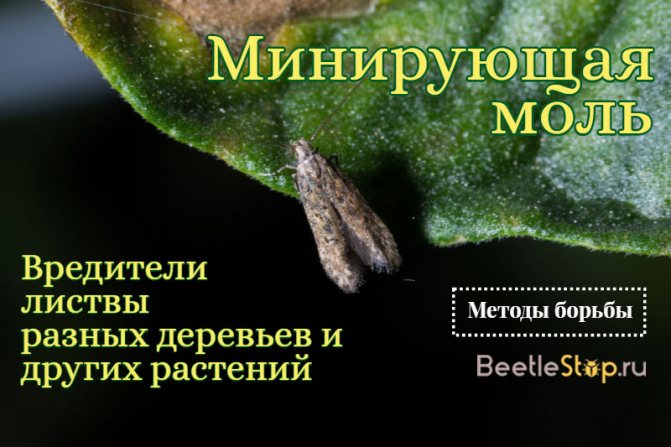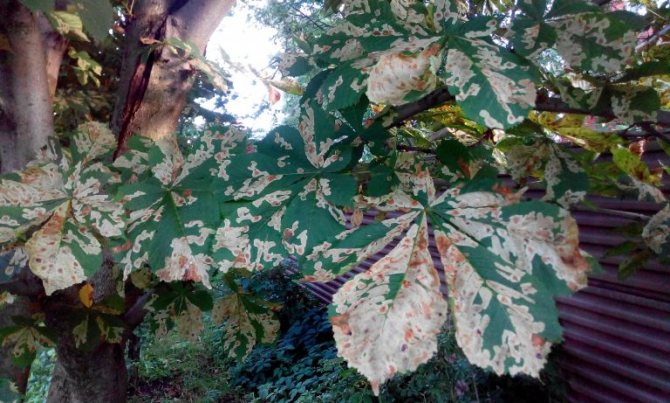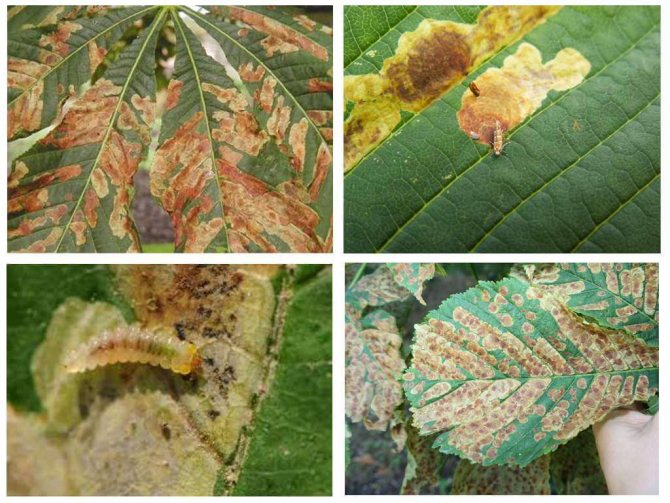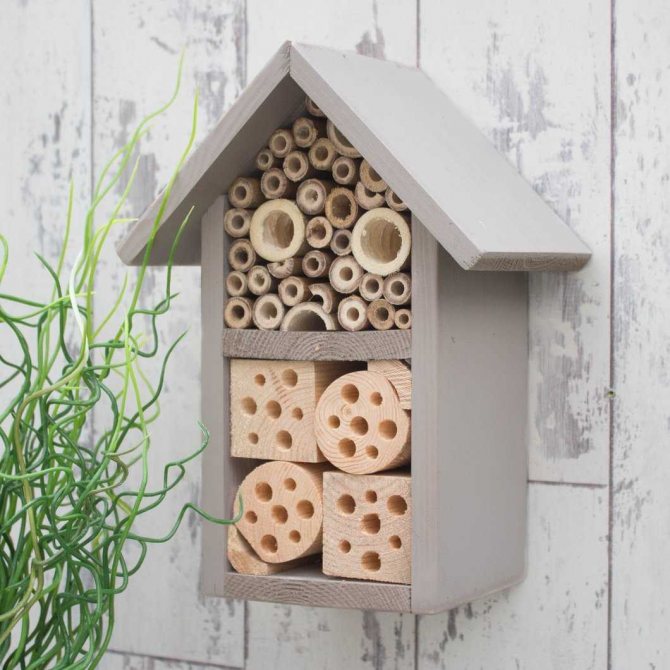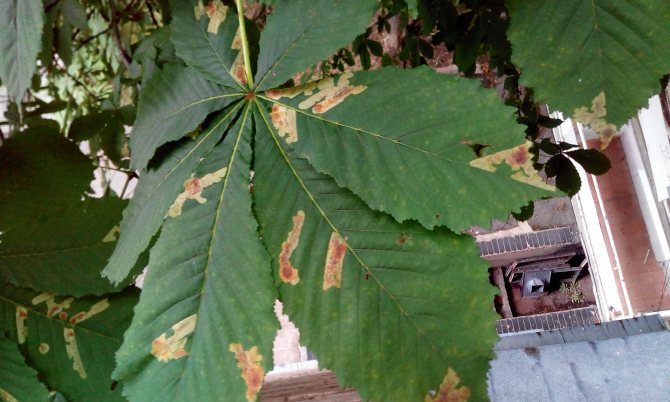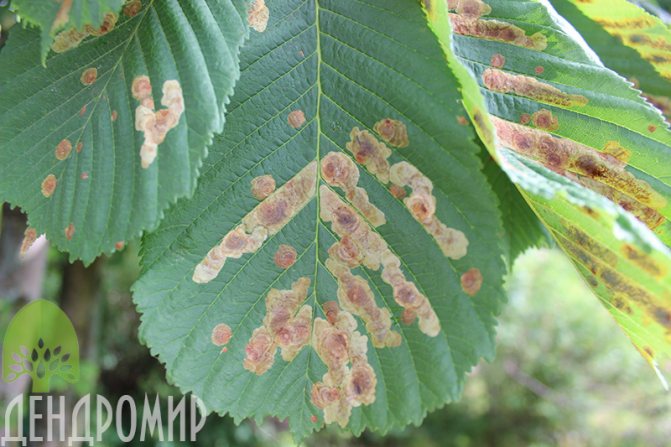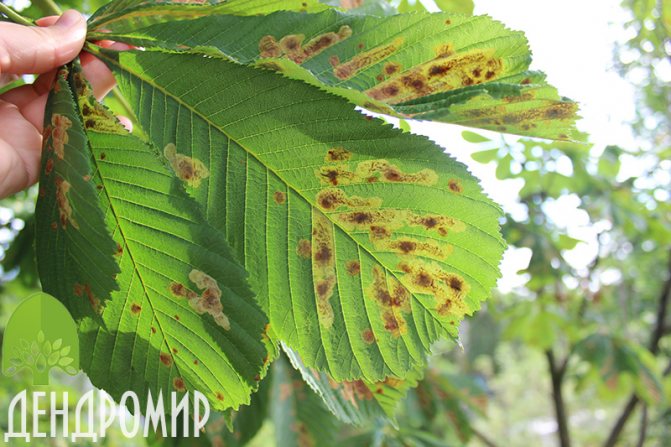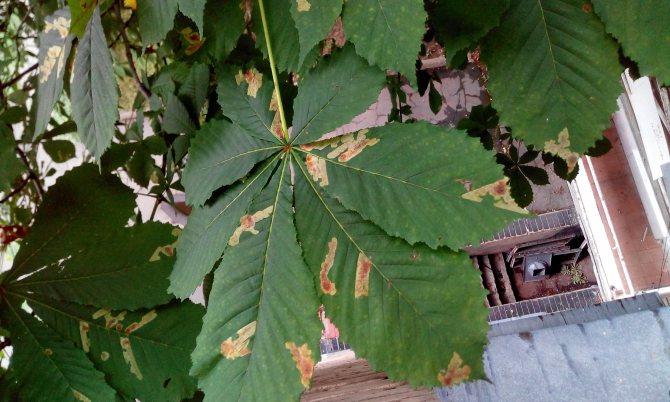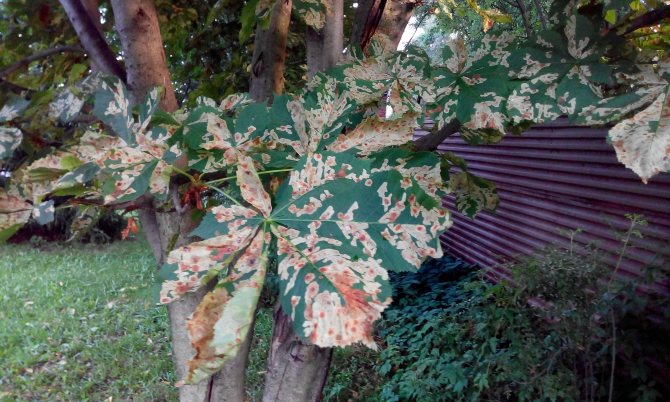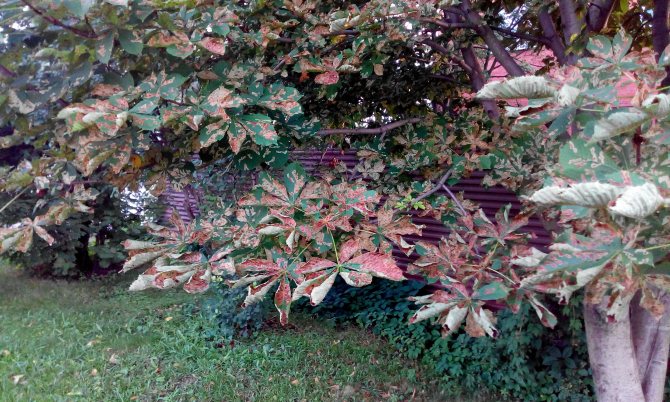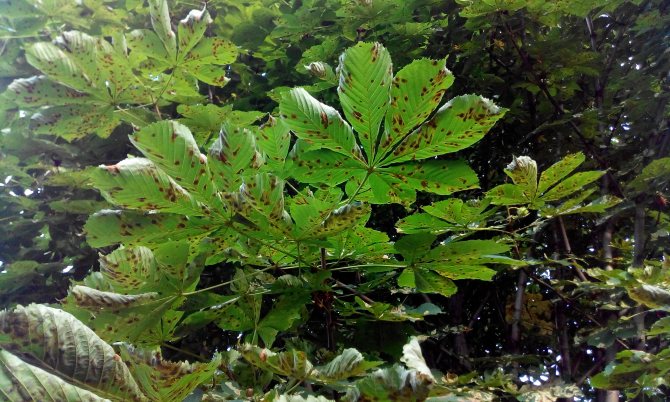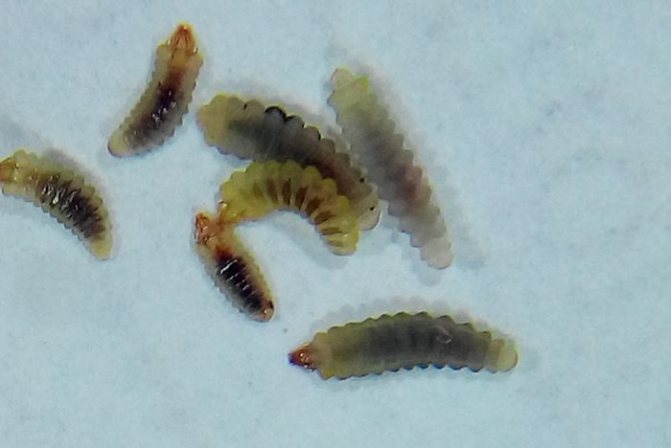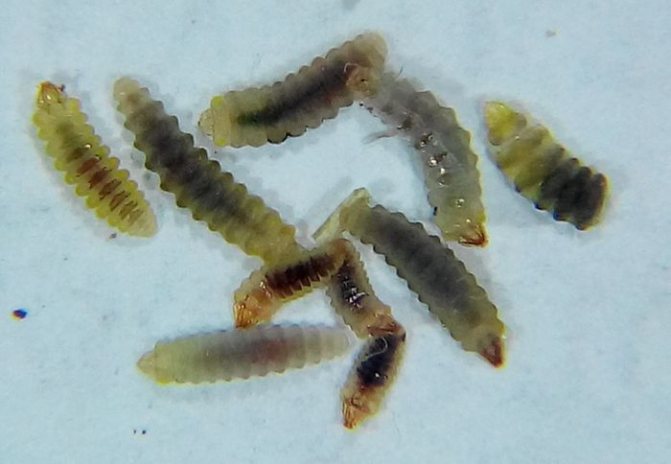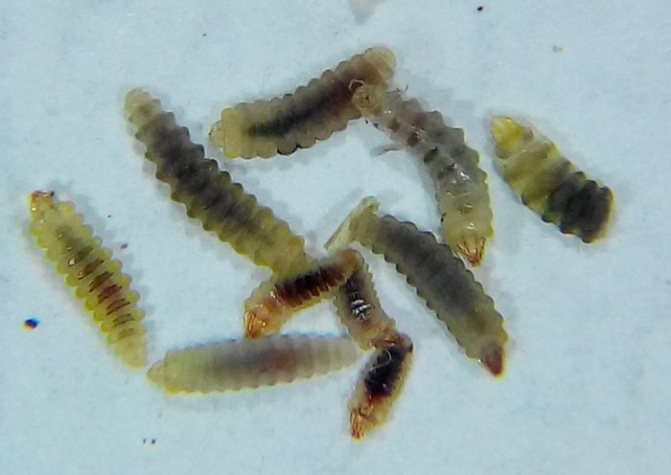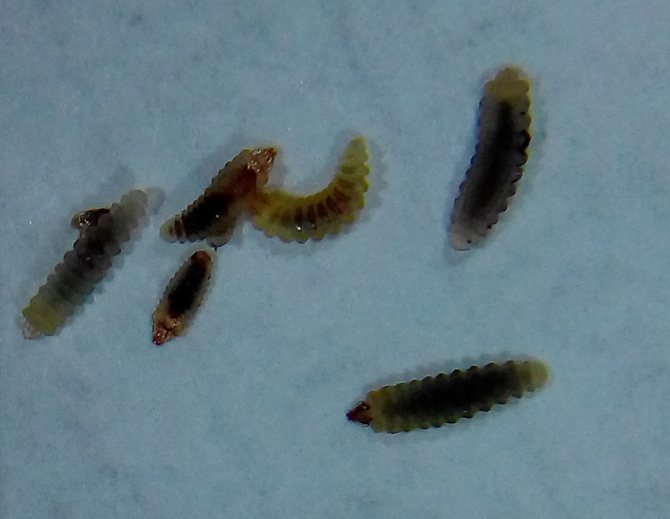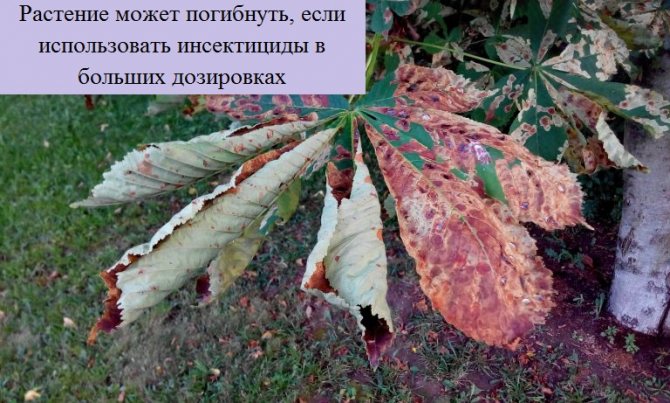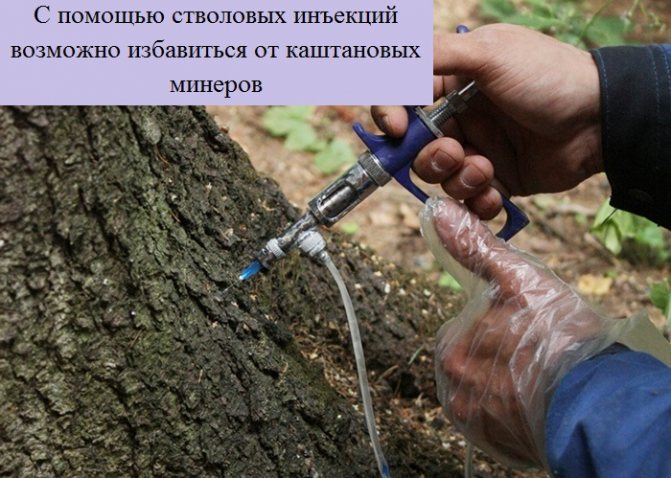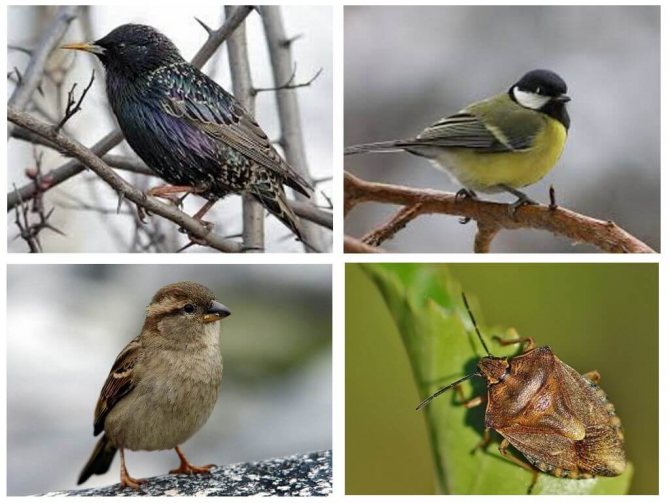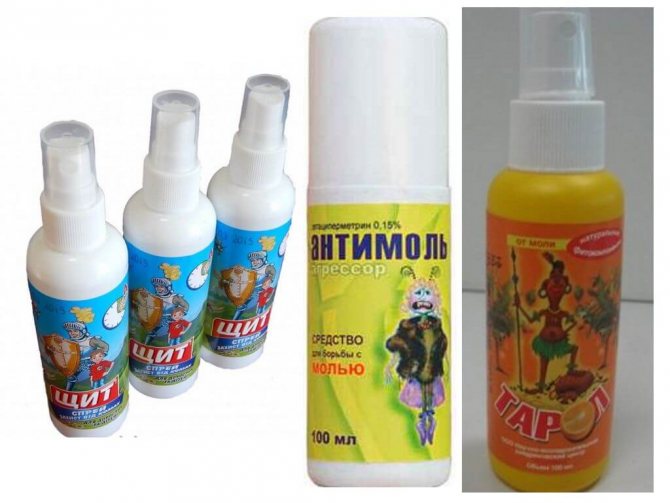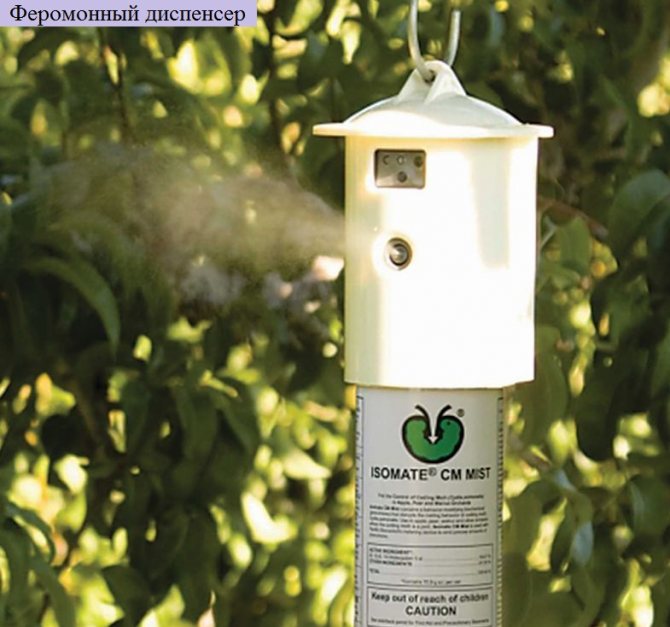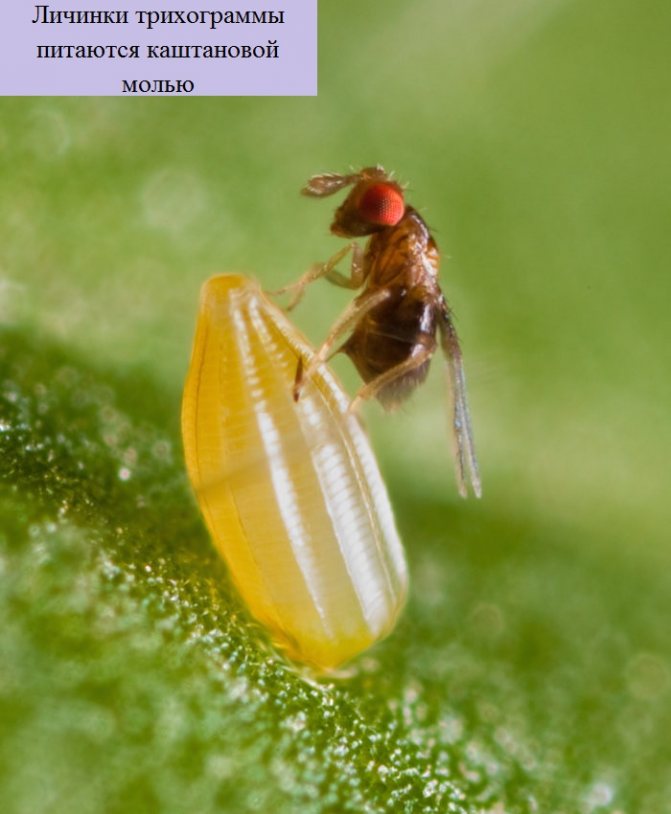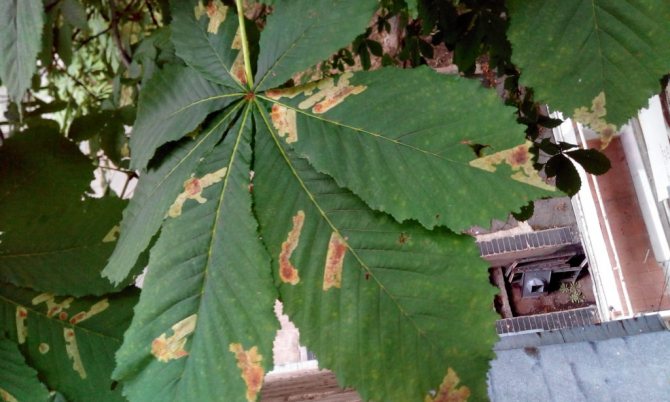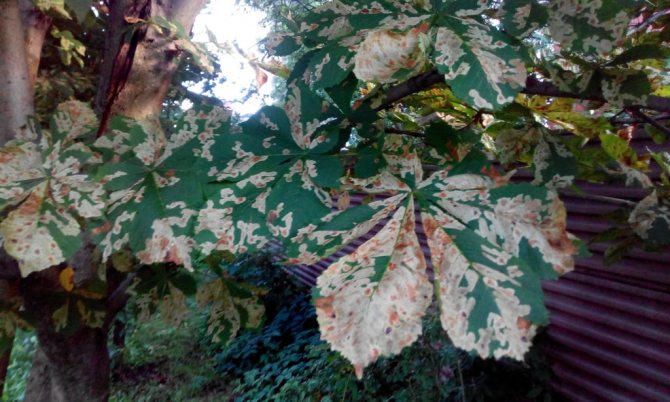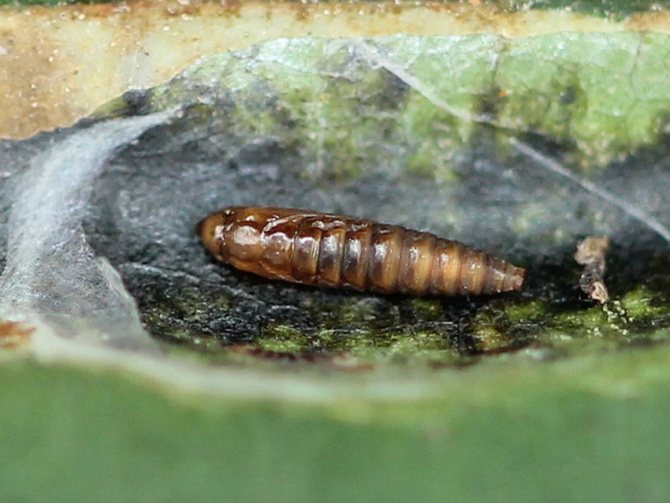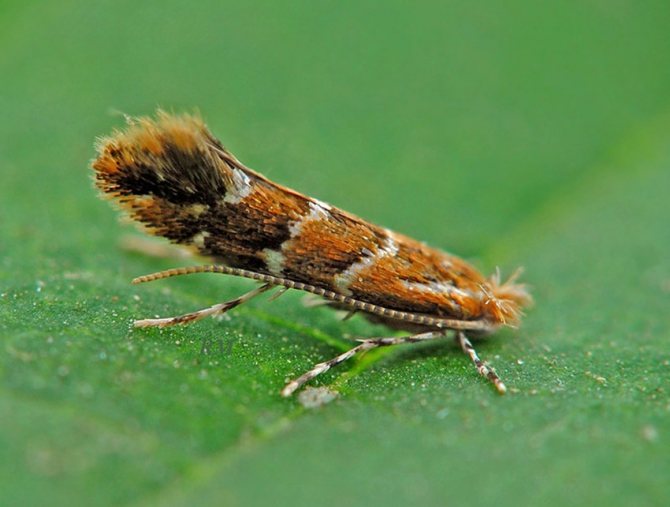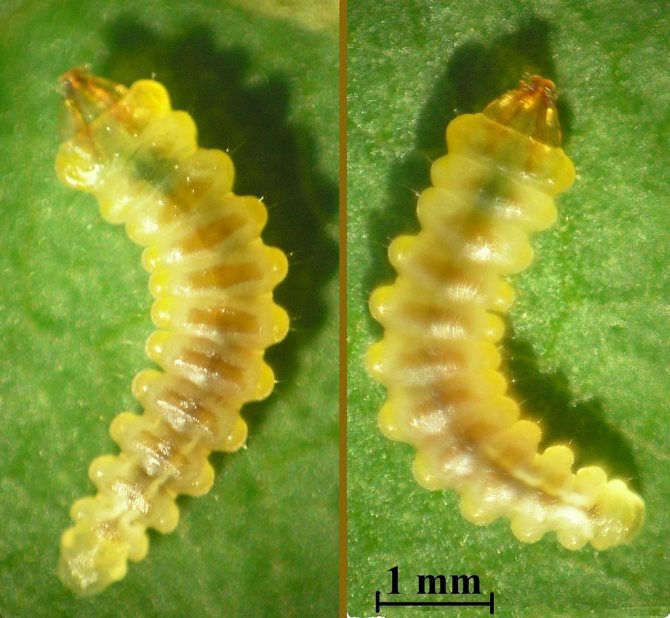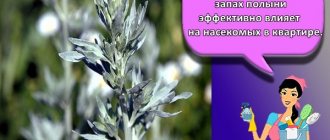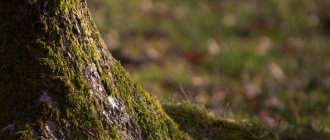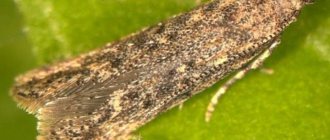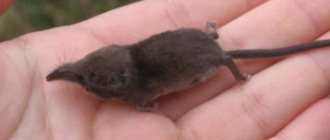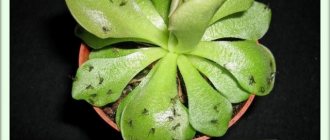Recently, ordinary horse chestnut (Aeskulus hippocastanum
). The plant is winter-hardy, tolerates city conditions well and is suitable for alley, group and single plantings. However, at the moment, the chestnut plantations are under threat due to the mass reproduction of a dangerous quarantine pest - the chestnut miner moth ().
Macedonia - Russia
Chestnut miner was first shown to be harmful in Macedonia in 1986. Described as a new species by Yugoslav entomolags in 1986 based on collections from 1984-1985, carried out in the area of Lake Ohrid (Macedonia).
In 2002, the pest appeared in Ukraine, in Lvov, in 2003 - in Kiev, as well as on the territory of the Kaliningrad region, in 2007 it was first discovered in Minsk. The pests entered Moscow in 2005. By now, the chestnut miner has been registered in most countries of Central, Eastern and Western Europe.
Chestnut, or Ohrid, miner, or chestnut miner (Cameraria ohridella Deschka & Dimic
), belongs to the order Lepidoptera
Lepidoptera
, to the suborder
Microlepidoptera
, the family of speckled moths
Gracellaridae,
family
Cameraria
.
The pest and its victims
This pest causes serious damage only to the common horse chestnut. Insignificant injuries were noted on K. to. Naked (A. glabra). In the Moscow region in 2007, numerous pest mines were identified on the chestnut site and single mines on the meat-red site. In single, small mines on Norway maple, the caterpillars of the chestnut miner died without completing their development.
Damage caused by the larvae of the chestnut tree moth significantly reduces the decorative effect of the plantings and contributes to their weakening.
Butterflies of the chestnut mining moth are small, with a wingspan of 6 mm. The forewings are lanceolate, variegated, silvery-buffy, with three diffuse white transverse bands, convexly curved towards the apex with uneven edges. The hindwings are buffy-gray with a silvery sheen, without a pattern. Long whitish-gray fringe along the perimeter of the wings.
The mass flight of butterflies occurs in May, coinciding with the flowering of the chestnut tree.
Apparently, the peculiarities of moth wintering ensured its wide distribution with planting material at numerous urban greening sites and private territories.
Butterflies of the miner moth Mina on a horse chestnut leaf Multiple mines on a horse chestnut leaf
Life Cycles
Females lay eggs one at a time on the upper surface of the leaf blades, mainly near the veins. The eggs are very small; the female covers each of them with a transparent secretion, which dries up over the egg in the form of a thin film. Embryonic development lasts 7-10 days. The hatched caterpillars of a grayish-green color gnaw out a cavity in the palisade tissue. At first, the mines are small, in the form of brownish rounded spots with a darker spot in the center and a lighter border along the edge. As the caterpillars grow, the mines become elongated; with dense populations, they can occupy almost the entire leaf blade. Sometimes there are several tens of minutes on one sheet.
During feeding, the caterpillars pass four instars, as well as two ages during their stay in the pupal chamber in the mine where pupation takes place. In 10-12 days, in the second or third decade of July, butterflies fly out. In the conditions of Moscow and the Moscow region, the butterfly gives two full-fledged generations. In 2008, this region saw the beginning of the development of the third generation.
Wintering of the second-generation mining chestnut moth takes place at the stage of the pupa in the fallen leaves or of a butterfly that huddled in cracks in the bark in the butt of trees. Apparently, the peculiarities of moth wintering ensured its wide distribution with planting material at numerous urban landscaping sites and private territories.
Control measures
To reduce the number of pests, it is recommended:
- in the fall, collect and remove mine-damaged leaves from the plantations;
- in spring, during the departure of butterflies from the wintering place, wash the butt part of the trunk with a strong stream of water;
- in the summer, during the flight of second generation butterflies, it is advisable to rewash the crowns and trunks of horse chestnut to prevent further dispersal and mass reproduction of butterflies.
Miner moths - small butterflies
, which include several families of small moths with a similar lifestyle and caterpillar diet, which
mine foliage of plants
, provoking its fall.
Distinctive characteristic
of these
insects
–
mine
, which differs in each species in shape and location in the sheet. They can be
tunnel-shaped
, stain or tunnel with a stain at the end.
Emerging from an egg laid on the inside of a leaf, larva
tomato moth
possesses
segmented, reminiscent
spindle shape and pale milky color
... Over time, the larva develops and becomes a caterpillar with movable limbs located on the thoracic and abdominal parts. Also have
caterpillars
a well-developed oral apparatus, due to which they are easy
gnaw
dense fiber
plants
.
An adult insect has a fairly large size
- the full wingspan reaches 2 centimeters, which
coupled with catchy color
, depending on the specific type,
makes it visible
... The pest develops quickly and
2 generations of caterpillars appear in 1 season
miner moth: early June and late July or early August.
Second generation
insects on the same plant several times
outnumbered the first
.
Harm
Caterpillars
miner moth
feed on plant foliage
causing them great damage.
Leaves
that were hit by a pest,
fall off earlier
time, and
the fruits are notget
required amount
nutrients.
Reference!
In the case of severe damage to plants and trees, the yield decreases, the amount of sugars, ascorbic acid and microelements in the fruits becomes less, the buds cease to form, the plant weakens and there is a risk of its death in winter.
The mining moth is dangerous because in the early stages of defeat it is not easy to notice
, and when the signs become obvious, it is almost impossible to save the plant. For example,
after a few years
insect colony life on a tree, large
part
his
the crown dries up
.
Important!
Adult pests carry viruses of many diseases, which can lead to epidemics in parks or greenhouses infected with them.
What is harmful?
As soon as a moth settles in a plant, it immediately begins to destroy its foliage. But this process is so slow that symptoms may not be noticeable even for several years
... To determine the presence of pests even before the appearance of external signs, you can use the scent. The impact of the presented pests will be marked by an unpleasant odor from the affected tree or shrub.
Green
The peculiarity of the green miner moth is that it can be active in the daytime.
Prefers such plants:
- Melons and gourds;
- Fruit and berry bushes;
- Tobacco;
- Celery;
It is possible to identify the pest only if a large number of punctures are found on the leaves.It prefers to feed on the juicy and soft part of the leaves, this is the zone along their edge.
Green moth:
South American Tomato Storm
The presented pest species is activated during the flowering of plants and prefers to migrate from one shrub to another, simultaneously affecting several crops.
Prefers to settle in such plant cultures:
- Eggplant;
- Potatoes;
- Tomatoes.
The pest destroys not only the leaves of the plant, but also its stems and fruits. As a result of the impact of the pest, drying of the plant, falling of its leaves, rotting of the root.
South American tomato moth:
Chestnut
REFERENCE:
The need to protect chestnuts from miner moths has already passed to the state level, since every year huge sums are allocated from the budget for treating trees with special preparations.
Cherry and apple moth
Cherries and apple trees are another favorite treats for the miner moth. The peculiarity of this type of pest is that they may well spend the winter period in the bark of the trunk, and with warming they begin their destructive effect.
As a result of the influence of moths on trees, they lag behind significantly in development, are characterized by a late period of flowering and the formation of ovaries.
Apple moth: how to deal with moths:
Control measures
For timely pest control, you need to understand what they are affected leaves
: on them
punctures are visible
, made by a thin proboscis of a mining moth, from which winding passages depart, the color of which depends on the type of insect.
If the lesion is serious, on the leaves large holes are formed
and their
the edges are thinning.
Also
on the back side
sheet plate can be seen
cocoon
- the "house" of the caterpillar, which, during the fall of the foliage, falls into the ground and
insect
no problem
going through the winter
, and after the snow melts, it enters an active phase.
If a defeat
plants
insignificantly
, you can try the following methods:
- collect and destroy
the whole
affected foliage
; - hang out adhesive boards
, to which insects will stick (and then die); - attract insects and birds
eating pests; - process trees rapeseed oil
or
mustard
; - pour water over a tree
under pressure, knocking down insects; - shelter
seedlings and garden beds
non-woven fabric
protecting against pest attacks.
Important!
Entomophages destroy 80-90% of caterpillars and 60-70% of pupae of mining moths.
In the case when the above methods were unsuccessful, it is necessary to use insecticides, such as "Dimilin", "Karate", "Confidor", "Aktara".
The most effective
drugs
- based
pyrethrum
, but when working with it, due to its high toxicity, it is necessary
take precautions
and the rules:
- to work in a mask
protecting all exposed areas of the body; - spray plants in the morning and evening
when insects destroying the miner moth are inactive; - spend processing
minimum
5 times
every
3-5 days
.
When the site is heavily infected, pyrethrum-containing drug
need deep
shed the beds
.
Important!
Due to the ability of insects to adapt to the applied poison, re-treatment should be carried out with a preparation with another active substance.
dangerous pest
that can be a hassle and can damage any plant. However, do not panic and say goodbye to the plantings. When
providing proper care
and
timely adoption of the correct measures to combat
with insects, you can defeat the miner moth and save the plants.
Ways to use chestnut against moths
Both raw and dried chestnuts can be used to combat the pest.They cope with the pest in the same way, but raw fruits can only be placed in well-ventilated places, since otherwise they will become moldy and there will be no sense from them. Therefore, it is best to collect the fruits and dry them in any convenient way, after which they are already placed on cabinets and shelves.
How to prepare the closet and spread out the repellent:
- It is important, before putting the chestnuts in the closet, to put things in order.
- Take out all the things, wipe the cupboard well, and then fold everything back.
- Place several pieces on the shelf between the clothes.
- The fruits are odorless and, if dried properly, will not stain clothes.
- The shelf life of chestnuts as a moth repeller is 2-3 years, but it is better to change them every year.
- Autumn came, they collected fresh fruits and replaced last year's ones.
It should be noted that chestnut seeds can also be used to combat food moths. The method of action is the same: remove everything unnecessary from the cabinets, wash them, fold everything back and put several chestnuts between the products.
Interestingly, chestnuts will do better when split open. To do this, you should:
- Break the round pieces into small pieces with a hammer.
- Wrap them in cloth bags.
- Arrange between items on the shelves.
Also, the flowers of this tree, which resemble white candles, are useful in the fight against the parasite. It is necessary to collect them, dry and grind into dust, and then put them in fabric bags and place them in a cabinet.
Useful video
Learn more about how to deal with tomato moths in the video:
The chestnut miner moth is a member of the small moth family, whose caterpillars in a unique way harm the leaves, gnawing paths in them. The name is derived from the previous explanation of the word "mine" - the creation of hidden passages. The greatest danger of the chestnut mining moth and other species of the family is that it is far from immediately possible to understand that the tree is infected. This most often occurs when the chestnut tree is already severely weakened or dead. It is worth spending one summer on a tree of a mining moth colony, most of the crown will no longer be saved.
Evaluation of the effectiveness of the "chestnut method"
Are chestnuts effective against caterpillars? In fact, there are no effective ways to combat moths. Even carefully carried out processing can only destroy the eggs, but not the larvae.
But chestnuts are a way out for those who cannot stand the smell of dichlorvos. It is worth noting that the presented method is completely safe for children and nursing mothers.

Arrange the chestnuts in the closet in no particular order. Don't forget to put a couple of things in the kitchen
Appearance description
Reaching the order of a centimeter at full wingspan. Its color is very bright: brick-red body (less often - orange) with white spots. Black scales are scattered on the body and legs. The miner moth in the photo looks pretty and harmless, but the appearance, as is often the case, is deceiving.
Its shape resembles a spindle, its body is painted in an unpleasant faded milky color. As it develops, the larva becomes a caterpillar with developed limbs located on the thoracic and abdominal parts. A mouth opening is gradually formed, with the help of which the pest is able to gnaw through dense chestnut leaves.
The egg laying time of the chestnut moth is not difficult to notice: during this period, they twine in large numbers around the chestnut. One individual is capable of laying about 50 eggs in one clutch. The larvae hatch after just a few days and penetrate directly from the eggs into the chestnut leaf. The larva is isolated from the environment, since the entrance hole is blocked by the egg - mine.
The development of the chestnut moth larva occurs in stages:
- The first three of them, it grows, gains weight. At this time, it feeds only on juice, begins to pave the way;
- The fourth stage is transformation into a caterpillar.From this moment, fiber nutrition begins, an active expansion of the living space;
- The fifth stage is the same caterpillar gaining weight;
- By the sixth stage, he stops eating, spins a thread for a cocoon.
After that, the insect pupates. In the pupa, the transformation into an adult occurs, which comes out into the light together with the chestnut flowering.
Plants that are affected by the chestnut miner
The main plants attacked by the chestnut moth are the white-flowering horse chestnuts (Japanese and common). However, some varieties of chestnuts (Chinese, Indian, Californian, etc.) do not attract butterflies, because on their leaves, caterpillars die already at the first stage of development.
In addition, the chestnut moth attacks other types of plants planted both in summer cottages and in city parks:
- decorative maples (white and holly);
- girlish grapes;
- shrubs (roses, holly, rhododendron).
Harm miner moth
This insect is dangerous to a huge number of different plants. The chestnut miner moth gnaws holes in the leaves, which leads to a significant weakening of the plant. Given that adults are capable of carrying viruses of various diseases, epidemics can occur in parks or greenhouses infected with them.
In one season, the chestnut moth is capable of making several clutches. Thus, by the end of the year, the leaves of the chestnut are riddled with passages that kill them, weakening the tree itself. As a result, many of them are unable to survive the winter.
Preventive measures
; among herbaceous plants -
Control measures against chestnut miner moths include the use of a trichogramma parasite parasitizing moth larvae, tree feeding and soil improvement, as well as the introduction of drugs based on Imidacloprid into the vessels of the tree - with it the leaves of the tree become poisonous to moths.
You can knock pests off the tree by pouring a stream of water under a strong pressure;
One of the varieties of leaf miners is the poplar moth, which activates during flowering and floods the apartments of residents, under whose windows poplars are planted.
Miner moths on cherries and other plants: methods of control on the example of one culture
There is a new method: holes are made in the trunks and insecticides are placed there, which make plants poisonous to moths for several years. However, there is a danger that the poison will get into the nectar and can poison bees and other beneficial insects when they collect nectar.
stop-
The miner moth lays eggs on the leaves of trees, then caterpillars hatch from them and begin to feed on plant sap. As they grow older, they gnaw through the passages in the leaves and already devour the tissue of the tree.
- Against the chestnut miner, a two-time application of the preparations Bi-58 new 40% k.e., Dimilin 25% s.p., Karate050SBm.s.s. , century with the addition of surfactants: Agro-surfactant or AgroSurfactant. Extra, etc.
Isolation of indoor plants with a fine mesh when exposed to a balcony or garden allows them to be protected from wind-blown miner flies.
Reference by topic: Aphids, butterflies and sawflies - how to fight in the garden
Examples of miners who have penetrated to us from other continents are chestnut, or
Goldenrod, balsam, strawberries, clover, clematis, sedum, euphorbia, bellflower, centaury, dandelion, violet
Destruction of the chestnut moth
Scientists have long wondered how to get rid of the chestnut miner moth, and all of its congeners, such as,. As a result of the study, it turned out that the fight can be waged in several ways, which are subdivided into chemical and biological methods. It is worth considering each of them separately.
It has been observed that the chestnut moth is food for some representatives of birds and insects:
- Tits, starlings and sparrows feast on the chestnut moth most actively. In the seasons when the insect attacks chestnuts, it is necessary to attract as many of these birds as possible to squares and parks;
- The miner moth is a favorite treat for tree bugs and several species of beetles;
- In order to save the plants affected by the miner moth, a trichogramma is released - a rider that lays eggs in the larvae of these insects. The larvae hatch from the eggs, feed on "miners" and gradually kill them.
Chemical method
Although the spraying method is quite effective, it is dangerous to use it on a chestnut on which a mining moth has settled, because these trees are usually planted in crowded places.
In recent years, a new method has been used: insecticides are placed in the holes of the trunks. This makes the plant unsuitable for the chestnut miner moth. However, experts fear that the poison can get into the composition of the nectar, which will lead to the poisoning of bees and other useful "flyers" collecting nectar.
The effectiveness of the chestnut method
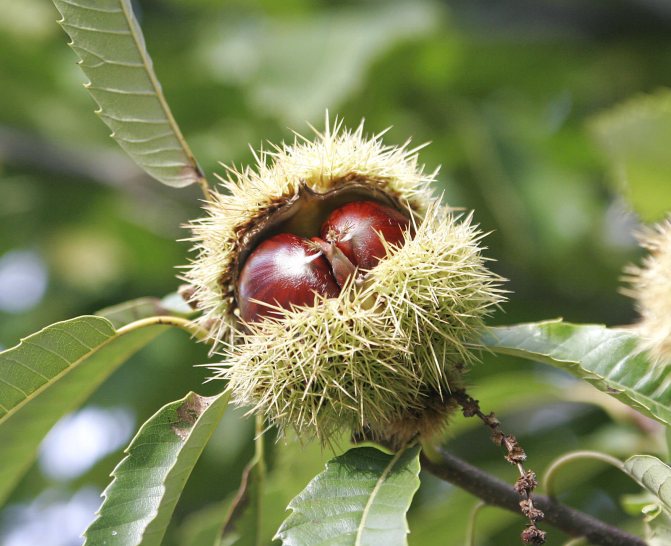

If we talk about the effectiveness of the "chestnut method" of fighting moths, then we can safely say that all means are good against moths. The main feature of the chestnut is its ability to scare away moth butterflies, preventing them from laying new eggs.
At the same time, they cannot harm the already deposited eggs and hatched larvae in any way. Therefore, as a means of repelling moths, these fruits are certainly effective.
But if the butterfly is already flying, then there are nests somewhere, from which you can get rid of in several ways:
- Throw away all contaminated items.
- If the clothes can still be saved, they should be washed and ironed.
- In case the item is made of fur, it is necessary to expose it either in the sun or in the cold. The insect does not withstand both high and low temperatures.
- Use chemicals to control moths. This is the least attractive method as these substances are toxic to both insects and humans. Therefore, you should think twice about which is more important - a fur hat or your own health, which, unlike a hat, you cannot buy.
Chestnut is effective as a moth repellant, but powerless if it has already started and laid eggs. Therefore, yes, it can and should be used in combination with other types of pest control.
Signs of damage and prevention
It is easy to distinguish the chestnut tree on which the colony has lived for a long time. Its sheets are completely or partially covered with dry areas, holes, ulcerations. It is difficult to detect a sign of a newly settled colony, since leaf damage is still almost invisible.
Prevention can be as follows:
- use chemicals by putting them in the trunks;
- collect fallen leaves and burn;
- spray chestnut trees and their leaves with spring oils;
- cover chestnut plantings with a canvas;
- get rid of insects by knocking them down with a strong stream of water.
How to scare a moth with a chestnut
Alternative methods can be used against the insect, for example, chestnut.
The application principle is quite simple:
- 6 inshell chestnuts are placed on the shelves with clothes;
- change them after a year.
There is another way: during the flowering of the chestnut, collect "white candles".
Rub them into dust and place in bags. Further, the bags are placed on the shelves in the cabinets.


Since each remedy is aimed either at scaring off or at destroying the parasite, the use of several simultaneously fulfills two goals at once - first it kills the insect, and then does not allow others to take its place
curious
Scientists have found out interesting facts about moths:
- For pupation, the caterpillar can not only spin its own silk, but also use a cocoon that has already been abandoned by someone;
- When unfavorable conditions occur, only pupae are capable of hibernation: the insect will die at other stages of development;
- One colony is capable of destroying several trees in a season.
Why is it so called: a mining moth or a miner? The fact is that the passages that its larvae gnaw inside the leaf blade, causing undoubted harm to the tree, are called "mines." According to biological characteristics, all moths, including miners, are a subspecies of butterflies.
Reference! Most miners specialize in a particular plant, switching to a related plant only in the absence of the main food.
Description
A small larva with a spindle-shaped segmented body hatches from an egg laid by a female mining moth. A little later, it turns into a caterpillar with its inherent mouth-gnawing apparatus, thanks to which it is able to gnaw fiber, feeding on leaf tissues.
An adult moth insect is a butterfly with a wingspan of up to two centimeters and a varied wing color, depending on the species to which a particular individual belongs.
Food
Insects feed on plant leaves, and the diversity is so great that it boggles the imagination, Even the conifers are amazed by their miners. Below are lists, far from complete, of quarantine objects, for example, trees:
- horse chestnut;
- Linden;
- holly;
- sycamore;
- Rowan;
- poplar;
- juniper;
- Apple tree;
- cherry;
- citrus.
Shrubs:
- rose flower;
- rosehip;
- hawthorn;
- honeysuckle;
- spirea.
Herbaceous plants:
- balsam;
- strawberries;
- clover;
- clematis;
- bell;
- centaury;
- dandelion;
- violet, including indoor.
Vegetables:
- tomatoes;
- potatoes;
- cucumbers;
- beet;
- salad;
- parsley;
- cabbage;
- melons and gourds;
- other.
Development
The moth years, the beginning of its reproduction, is familiar to every lover of nature, who in the summer was not far from the light source. Everyone saw how moths - moths - began to fly around the light bulb. Among them, there are also miners in large quantities.
Residents of suburban areas observe this for years in butterflies of apple and cherry miner moths.
After mating, the female lays on the leaves of a quarantine plant up to fifty small translucent testicles. The larvae appear in a few days and immediately penetrate inside the leaf plate, closing the entrance with an egg shell, a kind of shell.
After this, the growth and development of the larva begins, during which it passes through the molting stage several times.
The first three stages of development, from molting to molting, the larva feeds heavily, gaining growth and weight. then, in the fourth stage, a caterpillar appears and brings its body to readiness for pupation. The fifth stage is characterized by the production of a silk cocoon, after which the caterpillar pupates.
Reference! It should be noted that, depending on the species and climatic conditions, the mining moth can pass from one to five generations per season.
If the pupa stage falls on a cold time, then the development is suspended and in this state the miner leaves for wintering, an adult insect will appear only in the spring of next year, when the temperature permits.
How to fight: basic techniques and methods
Natural:


- removing and burning damaged leaves and carefully checking adjacent branches for new moves;
- covering the landings with a non-woven fabric at the time of the expected departure of the moth;
- creating conditions for the appearance of predatory insects in gardens and greenhouses that feed on caterpillars and adult moths;
- spraying with spring oils;
- knocking down swarming insects from trees with a strong jet of water.
Chemical
It should be used in conditions of severe damage to plants. Products containing pyrethrum are effective, but only in the case of multiple treatments over several days. Unfortunately, most of the chemicals do not work on pupae and very weakly on larvae.
The mining chestnut moth is a formidable pest that not only spoils the decorative appearance of chestnut leaves, but can also cause the death of trees. Consider the main methods of dealing with this insect.
As we already noted in the announcement of the article, a mining moth can cause the death of a chestnut. In order to prevent this from happening, it is necessary to fight the pest in advance. If you noticed earlier that the leaves of chestnuts already at the beginning of summer begin to lose their decorative appearance, rusty spots appear on them, and by the end of summer almost all the leaves on the trees are sick, then most likely the reason is a mining moth. The danger is that the activity of this pest is cyclical. And if in previous years the trees withstood the onslaught of the insect, then there is no guarantee that next year the number of moths will be the same and the trees will not die. For example, in the summer of 2014, an outbreak of a mining moth was observed in the Moscow region. The outbreak began due to a general decrease in precipitation. Any outbreak lasts at least two years, so it is safe to predict the growth of the moth population in the summer of 2015, regardless of weather conditions and other environmental factors.
Knowing the biology of the insect, you can take care of the health of chestnuts in advance. Insecticidal injections of trees or spraying of crowns with long-acting insecticides are used as preventive methods of combating miner moths. It is advisable to hold these events in May-June.
If the attack of the moth has already occurred, then it is necessary to add fungicide treatment to the listed measures, since the mining moth often infects the tree with dangerous fungal diseases. Depending on the type of selected fungicide, you can process the crown from the outside or inject the drug directly into the trunk.
It should be remembered that all drugs that are used in the fight against miner moths are quite harmful to the environment and humans. Therefore, it is always preferable to use the intravascular injection method. In this case, the effective dose of drugs is very small, and the effectiveness is higher than with traditional spraying of crowns. Injections are effective both for prophylaxis and for an already congested moth attack. In the first case, the moth prefers not to attack such trees, in the second, the larvae of the moth die almost immediately after the drug is injected into the trunk. The huge advantage of this method is its safety for people, animals and for the plant itself. Large doses of insecticides and especially fungicides can inhibit the plant, this does not happen when using intra-stem injections. However, this method also has its drawback - its high cost.
A miner moth is an insect that, as a result of its actions, provokes the death of plants. The danger of the appearance of such a pest lies in the fact that the obvious signs of a plant disease appear even when it cannot be saved. It can take several years from the moment the mining moth populates until the plant dies, while the number of pests is constantly increasing.
Tomant miner moth:
Types of miners
Here are examples of some of the mining moths that are most common in our gardens and vegetable gardens, and also damage green spaces that are easy for cities in the industrial age.
Chestnut miner
One of the worst representatives among the miners. It spread across Europe relatively recently, but the chestnut miner moth forced to take exceptional control measures. During the season, this pest is able to give three generations of offspring.
Tomato
The tomato mining moth spreads on tomatoes and other plants of the nightshade family: potatoes, eggplant, nightshade, physalis.
Tomato moth
The miner moth on tomatoes appears even in greenhouses.If the infection is not detected in time, you can lose a significant part of the harvest, because the diseased leaf does not completely provide the plant with photosynthetic products.
In addition to nightshade plants, tomato miner can damage pumpkin crops.
Yablonevaya
The pest of fruit trees is the apple miner moth, which also affects pears.
Cherry
What to do to save the tree
While breeders are looking for planting material that is genetically resistant to the pest, a reliable means of combating chestnut diseases has been found and has been successfully used for a long time. The most effective anti-moth treatment is tree trunk injection.


Only specially trained people should treat tree miner moths, using the correct equipment and materials. In addition, the fallen leaves of the chestnuts are carefully removed and destroyed so that the pupae of the moth have nowhere to winter.
Such manipulations prolong the life of chestnuts and reduce the moth population by 50-70%.
Plant protection
The fight against miner moths begins with preventive plant protection. There are many agricultural techniques that can be used to reduce the damage from damage to crops by these pests.
- Autumn harvesting of leaves with their subsequent laying in compost.
- Selection of plants that are not damaged by miners. Biologists usually cite chestnuts as an example, the small-flowered species does not affect the moth at all, and the larvae die from the meat-red leaves.
- Sifting soil for seedlings and planting holes will help get rid of pupae.
- The use of insect predators in greenhouses.
- Application of adhesive tapes to which butterflies can stick during the summer.
- Hand picking of diseased leaves.
- Washing off butterflies from foliage under the pressure of a water jet.
Attention! The use of glue traps can also kill beneficial insects, such as various pollinators. Therefore, their use is advisable only in a limited period of moth summer.
What to combine chestnut with for greater effectiveness?
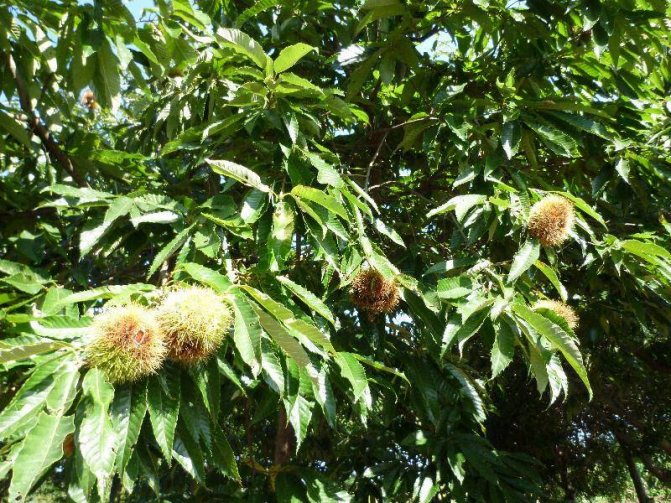

There are other folk methods of dealing with moths, which can and should be combined with each other. These include plants such as:
- fir twigs;
- tansy;
- citrus peel;
- dried lavender;
Plants should be pre-dried, laid out in fabric bags and placed on shelves.
It is also important to remember here that the longer the plant dries, the less chance it will become moldy, the more beneficial it will be. Such bags can be stored for up to six months, and the peel of lemon, orange, tangerine - no more than a month.
Also, strawberry soap is very effective. Housewives have long laid it out between the sheets in chests, not only to give them a magical scent, but also as a moth repellent.
It is important to remember that each of these means by itself is powerless, but in combination with each other they can save the owners from the problem with the nasty insect forever. Therefore, you should not dwell on the decomposition of chestnuts on the shelves. You should also place pouches of scented lavender and citrus peels on them. Also, other combinations are possible - what is at hand.
Chemical methods of pest control
Unfortunately, chemical methods are difficult to combat with chestnut miner moths, primarily because chestnut plantings are usually found where there are a lot of people. Spraying huge trees with toxic substances is inconvenient and dangerous for others.
There is a new method: holes are made in the trunks and insecticides are placed there, which make plants poisonous to moths for several years. However, there is a danger that the poison will get into the nectar and can poison bees and other beneficial insects when they collect nectar.


